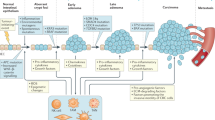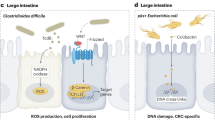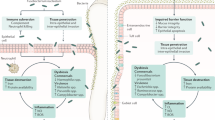Abstract
Many common cancers develop as a consequence of years of chronic inflammation. Increasing evidence indicates that the inflammation may result from persistent mucosal or epithelial cell colonization by microorganisms; including hepatitis B virus and hepatitis C virus, which can cause hepatocellular cancer; human papilloma virus subtypes, which cause cervical cancer, and the bacterium Helicobacter pylori, which can cause gastric cancer. At present, the cause of other chronic inflammatory conditions associated with increased cancer risk, such as ulcerative colitis, is obscure. Particular microbial characteristics as well as the type of the inflammatory response contribute to clinical outcomes via influence on epithelial cell and immune responses. Persistent inflammation leads to increased cellular turnover, especially in the epithelium, and provides selection pressure that result in the emergence of cells that are at high risk for malignant transformation. Cytokines, chemokines, free radicals, and growth factors modulate microbial populations that colonize the host. Thus, therapeutic opportunities exist to target the causative microbe, the consequent inflammatory mediator, or epithelial cell responses. Such measures could be of value to reduce cancer risk in inflammation-associated malignancies.
This is a preview of subscription content, access via your institution
Access options
Subscribe to this journal
Receive 12 print issues and online access
$209.00 per year
only $17.42 per issue
Buy this article
- Purchase on Springer Link
- Instant access to full article PDF
Prices may be subject to local taxes which are calculated during checkout


Similar content being viewed by others
References
Virchow R (1863) Cellular Pathology as Based upon Physiological and Pathological Histology. Philadelphia: JB Lippincott
Balkwill F and Mantovani A (2001) Inflammation and cancer: back to Virchow? Lancet 357: 539–545
Dvorak HF (1986) Tumors: wounds that do not heal. Similarities between tumor stroma generation and wound healing. N Engl J Med 315: 1650–1659
Pisani P et al. (1997) Cancer and infection: estimates of the attributable fraction in 1990. Cancer Epidemiol Biomarkers Prev 6: 387–400
Hussain SP et al. (2003) Radical causes of cancer. Nat Rev Cancer 3: 276–285
Preston-Martin S et al. (1990) Increased cell division as a cause of human cancer. Cancer Res 50: 7415–7421
Hahn WC and Weinberg RA (2002) Rules for making human tumor cells. N Engl J Med 347: 1593–1603
Abbas AK et al. (1996) Functional diversity of helper T lymphocytes. Nature 383: 787–793
DeClerck YA et al. (2004) Proteases, extracellular matrix, and cancer: a workshop of the path B study section. Am J Pathol 164: 1131–1139
Coussens LM and Werb Z (2002) Inflammation and cancer. Nature 420: 860–867
Parkin DM (2001) Global cancer statistics in the year 2000. Lancet Oncol 2: 533–543
Hohenberger P and Gretschel S (2003) Gastric cancer. Lancet 362: 305–315
Correa P et al. (1975) A model for gastric cancer epidemiology. Lancet 2: 58–60
Yuasa Y (2003) Control of gut differentiation and intestinal-type gastric carcinogenesis. Nat Rev Cancer 3: 592–600
Warren JR and Marshall B (1983) Unidentified curved bacilli on gastric epithelium in active chronic gastritis. Lancet 1: 1273–1275
IARC Working Group on the Evaluation of Carcinogenic Risks to Humans (1994) Schistosomes, liver flukes and Helicobacter pylori. IARC Monogr Eval Carcinog Risks Hum 61: 1–241
Peek RM and Blaser MJ (2002) Helicobacter pylori and gastrointestinal tract adenocarcinomas. Nat Rev Cancer 2: 28–37
Uemura N et al. (2001) Helicobacter pylori infection and the development of gastric cancer. N Engl J Med 345: 784–789
Huang J-Q et al. (1998) Meta-analysis of the relationship between Helicobacter pylori seropositivity and gastric cancer. Gastroenterology 114: 1169–1179
Helicobacter and Cancer Collaborative Group (2001) Gastric cancer and Helicobacter pylori: a combined analysis of 12 case control studies nested within prospective cohorts. Gut 49: 347–353
Ekstrom AM et al. (2001) Helicobacter pylori in gastric cancer established by CagA immunoblot as a marker of past infection. Gastroenterology 121: 784–791
Suerbaum S and Michetti P (2002) Helicobacter pylori infection. N Engl J Med 347: 1175–1186
Neugut AI et al. (1996) Epidemiology of gastric cancer. Semin Oncol 23: 281–291
Blaser MJ and Atherton JC (2004) Helicobacter pylori persistence: biology and disease. J Clin Invest 113: 321–333
Aspholm-Hurtig M et al. (2004) Functional adaptation of BabA, the H.pylori ABO blood group antigen binding adhesin. Science 305: 519–522
Censini S et al. (2001) Cellular responses induced after contact with Helicobacter pylori. Curr Opin Microbiol 4: 41–46
Higashi H et al. (2002) SHP-2 tyrosine phosphatase as an intracellular target of Helicobacter pylori CagA protein. Science 295: 683–686
Huang JQ et al. (2003) Meta-analysis of the relationship between cagA seropositivity and gastric cancer. Gastroenterology 125: 1636–1644
Blaser MJ et al. (1995) Infection with Helicobacter pylori strains possessing cagA is associated with an increased risk of developing adenocarcinoma of the stomach. Cancer Res 55: 2111–2115
Aras RA et al. (2003) Natural variation in populations of persistently colonizing bacteria affect human host cell phenotype. J Infect Dis 188: 486–496
Sommer F et al. (1998) Antrum- and corpus mucosa-infiltrating CD4(+) lymphocytes in Helicobacter pylori gastritis display a Th1 phenotype. Infect Immun 66: 5543–5546
Keates S et al. (1997) Helicobacter pylori infection activates NF-kappa B in gastric epithelial cells. Gastroenterology 113: 1099–1109
Ibraghimov A and Pappo J (2000) The immune response against Helicobacter pylori—a direct linkage to the development of gastroduodenal disease. Microbes Infect 2: 1073–1077
Crowe SE et al. (1995) Expression of interleukin 8 and CD54 by human gastric epithelium after Helicobacter pylori infection in vitro. Gastroenterology 108: 65–74
Hatz RA et al. (1997) Pattern of adhesion molecule expression on vascular endothelium in Helicobacter pylori-associated antral gastritis. Gastroenterology 112: 1908–1919
Ye G et al. (1997) Expression of B7-1 and B7-2 costimulatory molecules by human gastric epithelial cells: potential role in CD4+ T cell activation during Helicobacter pylori infection. J Clin Invest 99: 1628–1636
Engstrand L et al. (1989) Association of Campylobacter pylori with induced expression of class II transplantation antigens on gastric epithelial cells. Infect Immun 57: 827–832
Mohammadi M et al. (1997) Murine CD4 T-cell response to Helicobacter infection: TH1 cells enhance gastritis and TH2 cells reduce bacterial load. Gastroenterology 113: 1848–1857
Ramirez-Ramos A et al. (1997) Rapid recurrence of Helicobacter pylori infection in Peruvian patients after successful eradication. Gastrointestinal Physiology Working Group of the Universidad Peruana Cayetano Heredia and The Johns Hopkins University. Clin Infect Dis 25: 1027–1031
Fox JG et al. (2000) Concurrent enteric helminth infection modulates inflammation and gastric immune responses and reduces helicobacter-induced gastric atrophy. Nat Med 6: 536–542
El-Omar EM et al. (2000) Interleukin-1 polymorphisms associated with increased risk of gastric cancer. Nature 404: 398–402
Machado JC et al. (2001) Interleukin 1B and interleukin 1RN polymorphisms are associated with increased risk of gastric carcinoma. Gastroenterology 121: 823–829
Figueiredo C et al. (2002) Helicobacter pylori and interleukin 1 genotyping: an opportunity to identify high-risk individuals for gastric carcinoma. J Natl Cancer Inst 94: 1680–1687
Mannick EE et al. (1996) Inducible nitric oxide synthase, nitrotyrosine, and apoptosis in Helicobacter pylori gastritis: effect of antibiotics and antioxidants. Cancer Res 56: 3238–3243
Smoot DT et al. (2000) Influence of Helicobacter pylori on reactive oxygen-induced gastric epithelial cell injury. Carcinogenesis 21: 2091–2095
Juttner S et al. (2003) Helicobacter pylori stimulates host cyclooxygenase-2 gene transcription: critical importance of MEK/ERK-dependent activation of USF1/-2 and CREB transcription factors. Cell Microbiol 5: 821–834
Greten FR et al. (2004) IKKbeta links inflammation and tumorigenesis in a mouse model of colitis-associated cancer. Cell 118: 285–296
Wang TC et al. (2000) Synergistic interaction between hypergastrinemia and Helicobacter infection in a mouse model of gastric cancer. Gastroenterology 118: 36–47
Houben GM and Stockbrugger RW (1995) Bacteria in the aetio-pathogenesis of gastric cancer: a review. Scand J Gastroenterol Suppl 212: 13–18
Lipkin M et al. (1963) Cell Proliferation Kinetics in the Gastrointestinal Tract of Man. II: Cell Renewal in Stomach, Ileum, Colon, and Rectum. Gastroenterology 45: 721–729
Shirin H et al. (2001) Effects of H. pylori infection of gastric epithelial cells on cell cycle control. Front Biosci 6: E104–E118
Peek Jr, RM et al. (2000) Helicobacter pylori alters gastric epithelial cell cycle events and gastrin secretion in Mongolian gerbils. Gastroenterology 118: 48–59
Shirin H et al. (2000) Chronic Helicobacter pylori infection induces an apoptosis resistant phenotype associated with decreased expression of p27kip1. Infect Immun 68: 5321–5328
Houghton JM et al. (2004) Gastric cancer originating from bone marrow-derived cells. Science 306: 1568–1571
Correa P et al. (2000) Chemoprevention of gastric dysplasia: randomized trial of antioxidant supplements and anti-Helicobacter pylori therapy. J Natl Cancer Inst 92: 1881–1888
Ley C et al. (2004) Helicobacter pylori eradication and gastric preneoplastic conditions: a randomized, double-blind, placebo-controlled trial. Cancer Epidemiol Biomarkers Prev 13: 4–10
Leung WK et al. (2004) Factors predicting progression of gastric intestinal metaplasia: results of a randomised trial on Helicobacter pylori eradication. Gut 53: 1244–1249
Wong BC et al. (2004) Helicobacter pylori eradication to prevent gastric cancer in a high-risk region of China: a randomized controlled trial. JAMA 291: 187–194
Du MQ and Isaccson PG (2002) Gastric MALT lymphoma: from aetiology to treatment. Lancet Oncol 3: 97–104
Lecuit M et al. (2004) Immunoproliferative small intestinal disease associated with Campylobacter jejuni. N Engl J Med 350: 239–248
Coleman WB (2003) Mechanisms of human hepatocarcinogenesis. Curr Mol Med 3: 573–588
Chang MH et al. (1997) Universal hepatitis B vaccination in Taiwan and the incidence of hepatocellular carcinoma in children. Taiwan Childhood Hepatoma Study Group. N Engl J Med 336: 1855–1859
Koutsky LA et al. (2002) A controlled trial of a human papillomavirus type 16 vaccine. N Engl J Med 347: 1645–1651
Schreckenberger C and Kaufmann AM (2004) Vaccination strategies for the treatment and prevention of cervical cancer. Curr Opin Oncol 16: 485–491
Surh YJ et al. (2001) Molecular mechanisms underlying chemopreventive activities of anti-inflammatory phytochemicals: down-regulation of COX-2 and iNOS through suppression of NF-kappa B activation. Mutat Res 480–481: 243–268
Acknowledgements
Funding support, SFM: National Institutes of Health 1P20RR17695-01. MJB: National Institutes of Health RO1 GM 63270, and the Filomena D'Agostino Foundation.
Author information
Authors and Affiliations
Corresponding author
Ethics declarations
Competing interests
The authors declare no competing financial interests.
Glossary
- CYTOKINES
-
Intercellular soluble proteins that activate and regulate inflammatory and immune responses through interactions with specific receptors
- CHEMOKINES
-
Cytokines that function to recruit other inflammatory cells by chemo-attraction
- FREE RADICALS
-
Highly reactive oxygen by-products that contain unpaired electrons, created by normal cell metabolism
Rights and permissions
About this article
Cite this article
Moss, S., Blaser, M. Mechanisms of Disease: inflammation and the origins of cancer. Nat Rev Clin Oncol 2, 90–97 (2005). https://doi.org/10.1038/ncponc0081
Received:
Accepted:
Issue Date:
DOI: https://doi.org/10.1038/ncponc0081
This article is cited by
-
Genetic polymorphisms of interleukin-16 in Egyptian patients with primary knee osteoarthritis
Egyptian Rheumatology and Rehabilitation (2023)
-
Birth size and the serum level of biological age markers in men
Scientific Reports (2023)
-
Associations of body mass index, fasting insulin, and inflammation with mortality: a prospective cohort study
International Journal of Obesity (2022)
-
May Neutrophil Gelatinase-Associated Lipocalin (NGAL) Level Predict Mortality in Patients with Hepatocellular Carcinoma (HCC)?
Journal of Gastrointestinal Cancer (2020)
-
Studies on Cytological Anomalies of Microbial Co-infections in Cervical Lesions
Indian Journal of Gynecologic Oncology (2020)



